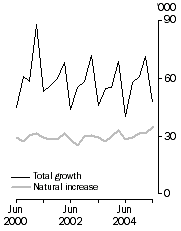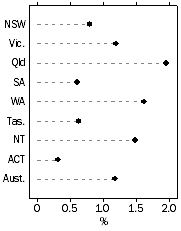JUNE KEY FIGURES
 | Population at end June qtr 2005 | Change over previous year | Change over previous year |  |
| PRELIMINARY DATA | '000 | '000 | % |  |
|  |
| New South Wales | 6 774.2 | 53.5 | 0.8 |  |
| Victoria | 5 022.3 | 59.4 | 1.2 |  |
| Queensland | 3 964.0 | 75.9 | 2.0 |  |
| South Australia | 1 542.0 | 9.3 | 0.6 |  |
| Western Australia | 2 010.1 | 32.0 | 1.6 |  |
| Tasmania | 485.3 | 3.0 | 0.6 |  |
| Northern Territory | 202.8 | 3.0 | 1.5 |  |
| Australian Capital Territory | 325.2 | 1.0 | 0.3 |  |
| Australia(a) | 20 328.6 | 237.1 | 1.2 |  |
|  |
| (a) Includes Other Territories comprising Jervis Bay Territory, Christmas Island and the Cocos (Keeling) Islands. |
Population growth, Quarterly

| Population growth rate, Year ended current quarter

|
JUNE KEY POINTS
ESTIMATED RESIDENT POPULATION
- The preliminary estimated resident population (ERP) of Australia at 30 June 2005 was 20,328,600 persons, an increase of 237,100 persons (1.2%) since 30 June 2004 and 47,200 persons since 31 March 2005.
- Preliminary natural increase for the year ended June 2005 was 127,000 persons. This represents an increase of 8,100 persons (6.8%) on the number recorded for the year ended June 2004 (118,900).
- Preliminary net overseas migration was 110,100 persons in the year ended June 2005, 10.1% higher than in the year ended June 2004 (100,000).
POPULATION GROWTH RATES
- The national growth rate during the 12 months ended June 2005 was 1.2%. This was the same as the estimated world's population growth rate during the 12 months ended June 2005.
- The Australian population grew by 0.2% during the June quarter 2005. Natural increase and net overseas migration contributed 53.6% and 46.4% respectively to Australia's total population growth in the year ended June 2005.
- During the June quarter 2005 all states and territories experienced positive population growth.
- Population gains were also recorded for all states and territories for the 12 months ended June 2005. Queensland recorded the largest gain (2.0% or 75,900 persons) and the Australian Capital Territory recorded the lowest (0.3% or 1,000 persons).
NOTES
FORTHCOMING ISSUES
| ISSUE (QUARTER) | Release Date |
| September 2005 | 21 March 2006 |
| December 2005 | 5 June 2006 |
| March 2006 | 21 September 2006 |
| June 2006 | 7 December 2006 |
| September 2006 | 22 March 2007 |
INTRODUCTION
Estimated resident population (ERP) data in this publication are based on the 2001 Census of Population and Housing. Exceptions are tables 17, 18 and 19 (excluding 2001 estimates), which are based on the 1996 Census of Population and Housing.
CHANGES IN THIS ISSUE
An international comparisons table of population growth rate and rank has been included in the Main Features of this issue.
Revisions included in this issue are as follows:
- Population estimates for Capital City Statistical Divisions and selected Statistical Districts have been revised for 2004. See Table 5 in this issue.
- Projected resident population for Capital Cities and total state/territory have been revised. See Table 8 in this issue.
- Standardised death rates published in Table 11 have been updated using revised deaths and ERP figures.
- Infant mortality rates published in Table 12 have been updated using revised infant deaths and ERP figures.
ERP DATA STATUS
At any point in time this publication contains final, revised and preliminary ERP data. The status of the ERP data included in this issue is as follows:
- Final - All ERP data up to and including June quarter 2001
- Revised - ERP data from September quarter 2001 to June quarter 2004, inclusive
- Preliminary - ERP data from September quarter 2004 to June quarter 2005, inclusive.
DATA NOT YET AVAILABLE
Progress is continuing with the review of annual household estimates methodology. See Tables 17, 18 and 19. A new methodology has been proposed and is currently being assessed. Implementation details will be made available once this assessment is complete.
INQUIRIES
For further information about these and related statistics, contact the National Information and Referral Service on 1300 135 070 or Cassandra Eaves on Canberra (02) 6252 5640.
MAIN FEATURES
INTRODUCTION
The preliminary estimated resident population (ERP) of Australia at 30 June 2005 was 20,328,600 persons, an increase of 237,100 (1.2%) since 30 June 2004 and 47,200 (0.2%) since 31 March 2005. The annual population growth rate (1.2%) was consistent with levels recorded in previous years.
INTERNATIONAL COMPARISON
For the 12 months ended June 2005 Australia's population growth rate (1.2%) was the same as the estimated growth rate of the world. Australia's growth rate was lower than Papua New Guinea (2.3%), Malaysia (1.8%), Singapore (1.6%), Indonesia (1.5%) and India (1.4%) and was higher than New Zealand (1.0%), United States of America and Canada (0.9%), Thailand (0.7%), China and Hong Kong (0.6%), United Kingdom (0.3%), Japan (0.1%) and Germany (which experienced almost no change).
According to the figures provided by the US Bureau of Census (International Data Base) for 227 countries (arranged from highest to lowest population size), Australia's population ranked 52nd in the year 2005 and is projected to rank 65th in 2050. By 2050, India is projected to become the most populous nation in the world, displacing China.
Population, Growth Rate and Rank, Selected countries - at 30 June |
|  |
 | Estimated Population | Projected Population | Rank |  |
 | 2004 | 2005 | Growth Rate | 2050 | 2005 | 2050 |  |
| Country | million | million | % | million | no. | no. |  |
|  |
| Australia | 20.1 | 20.3 | 1.2 | 28.1 | 52 | 64 |  |
| Canada | 32.5 | 32.8 | 0.9 | 41.4 | 35 | 43 |  |
| China | 1 298.8 | 1 306.3 | 0.6 | 1 424.2 | 1 | 2 |  |
| Germany | 82.4 | 82.4 | 0.0 | 73.6 | 14 | 22 |  |
| Hong Kong (SAR of China) | 6.9 | 6.9 | 0.6 | 6.2 | 98 | 116 |  |
| India | 1 065.1 | 1 080.3 | 1.4 | 1 601.0 | 2 | 1 |  |
| Indonesia | 238.5 | 242.0 | 1.5 | 336.2 | 4 | 5 |  |
| Japan | 127.3 | 127.4 | 0.1 | 99.9 | 10 | 17 |  |
| Malaysia | 23.5 | 24.0 | 1.8 | 43.1 | 46 | 42 |  |
| New Zealand | 4.0 | 4.0 | 1.0 | 4.8 | 122 | 125 |  |
| Papua New Guinea | 5.4 | 5.5 | 2.3 | 10.7 | 106 | 92 |  |
| Singapore | 4.4 | 4.4 | 1.6 | 4.6 | 120 | 130 |  |
| Thailand | 63.7 | 64.2 | 0.7 | 69.3 | 19 | 25 |  |
| United Kingdom | 60.3 | 60.4 | 0.3 | 64.0 | 22 | 29 |  |
| United States of America | 293.0 | 295.7 | 0.9 | 420.1 | 3 | 3 |  |
| World | 6 376.9 | 6 451.1 | 1.2 | 9 224.4 | . . | . . |  |
|  |
| . . not applicable |
| Source: ABS for Australian estimates and projected populations (Series B); US Bureau of Census, International Data Base (IDB) for selected countries and world estimated and projected populations and all rankings. |
COMPONENTS OF AUSTRALIA'S POPULATION CHANGE
The growth of Australia's population has two components: natural increase (the number of births minus the number of deaths) and net overseas migration (net permanent and long-term movement).
Natural increase
Preliminary natural increase for the June quarter 2005 was 35,000 persons, an increase of 23.7% from the number recorded in the June quarter 2004. This increase is due to more births (up 9.9%) and fewer deaths (down 1.9%). The preliminary number of births registered during the June quarter 2005 was 67,500 while the number of deaths registered was 32,400.
Natural increase for the year ended 30 June 2005 was 127,000 persons, contributing 53.6% to Australia's annual population growth. During this period, births added 257,900 babies to the population and deaths removed 130,900 people.
The estimated number of births has increased for each of the last two financial years. The total fertility rate for 2004-2005 increased to just under 1.8 babies per woman, the second consecutive financial year of increase.
Due to the collection and estimation method applied to produce these statistics, users should exercise caution when analysing and interpreting the most recent annual and quarterly births estimates, particularly when making time series comparisons. The Australian Bureau of Statistics (ABS) recommends users refer to Births, Australia (cat. no. 3301.0) for analysis of fertility trends over time. See paragraph 7 of the Explanatory Notes for more detail.
Net overseas migration
For the June quarter 2005 net overseas migration was 12,200 persons, an increase of 1.0% from the June quarter 2004.
For the year ended 30 June 2005 net overseas migration (110,100 persons) contributed 46.4% to Australia's population growth.
The ABS applies a number of adjustments to the overseas arrivals and departures data used to produce estimates of net overseas migration (NOM). These mainly comprise adjustments designed to reflect differences between stated travel intentions and actual travel behaviour, but (in the case of revised NOM estimates) also include adjustments to transform numbers of overseas movements into numbers of travellers. These are collectively referred to as 'migration adjustments'. For more information see the Technical Note - Measuring Net Overseas Migration.
STATES AND TERRITORIES
Population
Populations for the states and territories at 30 June 2005 were as follows: New South Wales 6,774,200, Victoria 5,022,300, Queensland 3,964,000, South Australia 1,542,000, Western Australia 2,010,100, Tasmania 485,300, Northern Territory 202,800, and the Australian Capital Territory 325,200.
Growth rates
All states and territories recorded positive population growth during the June quarter 2005. The Northern Territory and Queensland recorded the highest growth rates (0.5%), followed by Western Australia (0.3%), Victoria (0.2%), and New South Wales, South Australia and Tasmania (0.1%). The Australian Capital Territory experienced almost no change.
Similarly, all states and territories recorded positive growth for the year ended 30 June 2005. The highest annual growth rate was recorded by Queensland (2.0%), followed by Western Australia (1.6%), the Northern Territory (1.5%), Victoria (1.2%), New South Wales (0.8%), Tasmania and South Australia (0.6%), and the Australian Capital Territory (0.3%).
Interstate migration
During the June quarter 2005 Queensland, Western Australia, the Northern Territory and Tasmania recorded net interstate migration gains, while the remaining states and the Australian Capital Territory recorded net losses.
Interstate migration was the largest contributor (41.5%) to Queensland's annual population growth during the year ended 30 June 2005, with a gain of 31,500 persons. Net gains were also recorded for Western Australia (1,500 persons) and Tasmania (190 persons), and the Northern Territory recorded a negligible increase. New South Wales lost the largest number of persons through interstate migration (-25,700 persons), followed by South Australia (-3,500 persons), Victoria (-2,400 persons) and the Australian Capital Territory (-1,600).
NET INTERSTATE MIGRATION, States and territories

 Print Page
Print Page
 Print All
Print All